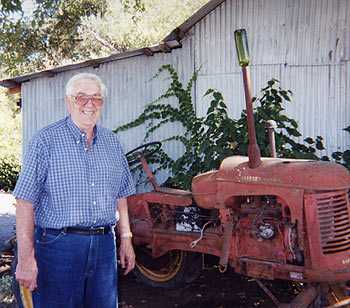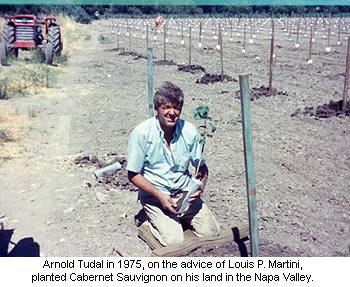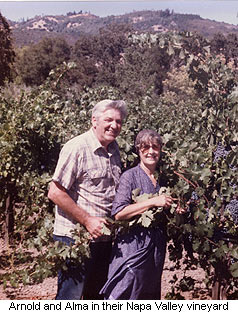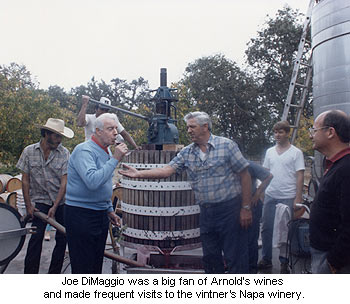

Arnold "Lucky" Tudal, Napa Valley's congenial "old-timer," and founder of Tudal Winery, passed away July 2, 2006 at the age of 82
St. Helena ~ Napa Valley (AVA)
Remembering Arnold "Lucky" Tudal
“Tudal's methodical, consistent approach to winegrowing…afforded his wines the luxury of possessing true terroir. While the Bordeaux first growths consistently herald their terroir, only a handful of Tudal's California peers share the distinction.”
~ Jeff Cox
by
Alan Goldfarb
July 8, 2006
This is the kind of guy Arnold Tudal (the founder of Tudal Winery in the Napa Valley), who passed away July 2 at the age of 82, was. According to Ray Ratto, a sports columnist for the San Francisco Chronicle, recalling his first visit many years ago to the St. Helena property, when relating a story at his memorial in Alameda:
“There was ‘Lucky,’” Ratto said, referring to Tudal’s nickname, “he was coming out of the winery, wiping his hands with a rag. He introduced himself and said pointing, ‘There’s where we make the shit, and here’s where we drink it.’ It was supposed to be a 30-minute visit, but when Alma (Tudal’s wife of 60 years) came out with a plate of food, it turned into three hours.”
Tudal, who was a longtime produce farmer, who became known as “the king of radishes,” owned a parcel of land on the island of Alameda across from Oakland. But he really got lucky when he arrived in the Napa Valley at the right moment. It was 1972, and although it was one of the worst years in the history of the valley due to unrelenting rain that drenched the harvest, it also marked the beginning of the wine boom that was to put the Napa Valley on the map. Four years later, with the vintage of ’73, two Napa Valley wines beat out a host of French wines in Paris, thereby sealing the region’s wine efficacy forever.
But he really got lucky when he arrived in the Napa Valley at the right moment. It was 1972, and although it was one of the worst years in the history of the valley due to unrelenting rain that drenched the harvest, it also marked the beginning of the wine boom that was to put the Napa Valley on the map. Four years later, with the vintage of ’73, two Napa Valley wines beat out a host of French wines in Paris, thereby sealing the region’s wine efficacy forever.
It wouldn’t be until ’82 when Tudal released his first wine – a 1979 Cabernet Sauvignon that Louis P. Martini advised him to plant, saying, “You’re sitting on great Cabernet land.” With the advice from Martini, and bench grafts from Dan Duckhorn, consulting from Charles Ortman, and a $1.98 book titled, “How to Make Wine,” Arnold Tudal turned his 10 acres that had been a walnut grove on Big Tree Road a few miles north of St. Helena, into a hobby “run amok.”
Tudal’s wines were never considered great, nor where they very well-known, but they were good wines and well-made.
Writing in 1989 in his “California’s Great Cabernets,” James Laube included two pages on the Tudal Winery, rated them well, but said, “While the Tudal Cabernets are consistently well made and occasionally exceptional in quality, they are not especially well-known, even in Napa Valley, as the proprietor keeps a low profile.”
While Arnold Tudal didn’t revel in the spotlight, he apparently knew how to live life. One of his “Arnoldisms” went something like this: “Rain makes the vines grow, the vines make the wine flow, oh lord, let it rain!”
Jeff Cox, in a 2000 article for Wine Magazine said of Tudal, “The consistency of flavor speaks to the constancy of his site and its natural environment, while his winemaking technique shows he's careful about guarding that consistency. It is fair to say, too, that his vineyard shares some rare characteristics with those of Bordeaux's first growths, which also show remarkable consistency of flavor and quality, even when the quality of the lesser growths is fluctuating through the poorer vintages.”
Researching a book in ‘83, when Cox arrived in the Napa Valley he said, “I sought advice from the place that usually has its finger on the pulse of the community, the local newspaper. The only person at the St. Helena Star, a weekly serving the upper Napa Valley, was a lanky, sandy-haired man sitting at his typewriter. I introduced myself and asked, ‘Who do you think makes the best wine in the Napa Valley?’ Hesitating for barely a heartbeat, he said, ‘Arnold Tudal is doing about as good a job as anyone, and he doesn't get a lot of credit for it.
“At the time, he'd had only two commercial releases under his belt, the 1979 and 1980, but we tasted the 1981 and 1982 from the barrel. Even then, I recognized the common thread in those wines – textural and flavor similarities that have remained true right up to the 1997, Tudal Winery's current release.”
Continued Cox regarding the terroir of Tudal’s vineyard, "The soil here is interesting as hell," Tudal says. "I'd be using the tractor in the vineyards and everything would be fine, and suddenly it would sink up to its axles in silt. I realized that I have three bands of very different soils laid down by the Napa River's overflow over the years."
From the tree line along the river for 100 feet west, the soil is soft, friable, sandy silt. "You can hardly find a pebble in it, let alone a rock," he says. From there to about 250 feet out, the soil is clay, while the last strip is gravelly clay loam strewn with boulders and rocks. "I'd have the whole family picking rocks out of this strip on weekends then we'd go have a big spaghetti dinner," he remembers fondly.”
Deep, gravelly sands, such as the soil in Tudal’s acreage closest to the river, force deep, sparse roots to reach down for water. Heavy clays, such as the soil that makes up his second band, hold more water, but hold it more tightly, so that it's only slowly available to the roots that grow closer to the surface.
Concluded Cox, “Tudal's methodical, consistent approach to winegrowing – together with superior fruit, a favorable climate and a generous degree of topographical serendipity – have afforded his wines the luxury of possessing true terroir. While the Bordeaux first growths consistently herald their terroir, only a handful of Tudal's California peers share the distinction.”
Tudal, who was involved in youth sports when he lived in Alameda, befriended former Oakland A’s pitching star Vida Blue, and he hung around with sportswriters.
 In addition to Ray Ratto, Sam Spear, a former sportswriter and sports publicist, who became a longtime friend, likes to tell a story of how Tudal regarded his wines.
In addition to Ray Ratto, Sam Spear, a former sportswriter and sports publicist, who became a longtime friend, likes to tell a story of how Tudal regarded his wines.
“He would never sell me any wine until the sun went down,” Spear related. “He was afraid that if I carried the wine around in the backseat of my car, the sun would spoil it. He didn’t want me to think that he made bad wine.”
A self-taught man without a college education or a degree in oenology, nonetheless Arnold Tudal spoke four languages including Spanish, French, and two dialects of Italian. Tudal was of Norwegian descent, but the family left Norway for France many generations ago with his family eventually settling in Lynn, Massachusetts. He never lost his New England accent.
With some of his family in Bordeaux, he once brought one of his wines and gave it to his 88-year-old great aunt. She tasted it, just knew it was from Bordeaux but said of it, “but it’s like a young baby.” When told it was from California she uttered, “qu’est-ce California?” By 1997, Tudal’s health began to deteriorate. Although generally considered an excellent vintage yea
“There was ‘Lucky,’” Ratto said, referring to Tudal’s nickname, “he was coming out of the winery, wiping his hands with a rag. He introduced himself and said pointing, ‘There’s where we make the shit, and here’s where we drink it.’ It was supposed to be a 30-minute visit, but when Alma (Tudal’s wife of 60 years) came out with a plate of food, it turned into three hours.”
Tudal, who was a longtime produce farmer, who became known as “the king of radishes,” owned a parcel of land on the island of Alameda across from Oakland.
 But he really got lucky when he arrived in the Napa Valley at the right moment. It was 1972, and although it was one of the worst years in the history of the valley due to unrelenting rain that drenched the harvest, it also marked the beginning of the wine boom that was to put the Napa Valley on the map. Four years later, with the vintage of ’73, two Napa Valley wines beat out a host of French wines in Paris, thereby sealing the region’s wine efficacy forever.
But he really got lucky when he arrived in the Napa Valley at the right moment. It was 1972, and although it was one of the worst years in the history of the valley due to unrelenting rain that drenched the harvest, it also marked the beginning of the wine boom that was to put the Napa Valley on the map. Four years later, with the vintage of ’73, two Napa Valley wines beat out a host of French wines in Paris, thereby sealing the region’s wine efficacy forever.It wouldn’t be until ’82 when Tudal released his first wine – a 1979 Cabernet Sauvignon that Louis P. Martini advised him to plant, saying, “You’re sitting on great Cabernet land.” With the advice from Martini, and bench grafts from Dan Duckhorn, consulting from Charles Ortman, and a $1.98 book titled, “How to Make Wine,” Arnold Tudal turned his 10 acres that had been a walnut grove on Big Tree Road a few miles north of St. Helena, into a hobby “run amok.”
Tudal’s wines were never considered great, nor where they very well-known, but they were good wines and well-made.
Writing in 1989 in his “California’s Great Cabernets,” James Laube included two pages on the Tudal Winery, rated them well, but said, “While the Tudal Cabernets are consistently well made and occasionally exceptional in quality, they are not especially well-known, even in Napa Valley, as the proprietor keeps a low profile.”
While Arnold Tudal didn’t revel in the spotlight, he apparently knew how to live life. One of his “Arnoldisms” went something like this: “Rain makes the vines grow, the vines make the wine flow, oh lord, let it rain!”
Jeff Cox, in a 2000 article for Wine Magazine said of Tudal, “The consistency of flavor speaks to the constancy of his site and its natural environment, while his winemaking technique shows he's careful about guarding that consistency. It is fair to say, too, that his vineyard shares some rare characteristics with those of Bordeaux's first growths, which also show remarkable consistency of flavor and quality, even when the quality of the lesser growths is fluctuating through the poorer vintages.”
Researching a book in ‘83, when Cox arrived in the Napa Valley he said, “I sought advice from the place that usually has its finger on the pulse of the community, the local newspaper. The only person at the St. Helena Star, a weekly serving the upper Napa Valley, was a lanky, sandy-haired man sitting at his typewriter. I introduced myself and asked, ‘Who do you think makes the best wine in the Napa Valley?’ Hesitating for barely a heartbeat, he said, ‘Arnold Tudal is doing about as good a job as anyone, and he doesn't get a lot of credit for it.
“At the time, he'd had only two commercial releases under his belt, the 1979 and 1980, but we tasted the 1981 and 1982 from the barrel. Even then, I recognized the common thread in those wines – textural and flavor similarities that have remained true right up to the 1997, Tudal Winery's current release.”

Continued Cox regarding the terroir of Tudal’s vineyard, "The soil here is interesting as hell," Tudal says. "I'd be using the tractor in the vineyards and everything would be fine, and suddenly it would sink up to its axles in silt. I realized that I have three bands of very different soils laid down by the Napa River's overflow over the years."
From the tree line along the river for 100 feet west, the soil is soft, friable, sandy silt. "You can hardly find a pebble in it, let alone a rock," he says. From there to about 250 feet out, the soil is clay, while the last strip is gravelly clay loam strewn with boulders and rocks. "I'd have the whole family picking rocks out of this strip on weekends then we'd go have a big spaghetti dinner," he remembers fondly.”
Deep, gravelly sands, such as the soil in Tudal’s acreage closest to the river, force deep, sparse roots to reach down for water. Heavy clays, such as the soil that makes up his second band, hold more water, but hold it more tightly, so that it's only slowly available to the roots that grow closer to the surface.
Concluded Cox, “Tudal's methodical, consistent approach to winegrowing – together with superior fruit, a favorable climate and a generous degree of topographical serendipity – have afforded his wines the luxury of possessing true terroir. While the Bordeaux first growths consistently herald their terroir, only a handful of Tudal's California peers share the distinction.”
Tudal, who was involved in youth sports when he lived in Alameda, befriended former Oakland A’s pitching star Vida Blue, and he hung around with sportswriters.
 In addition to Ray Ratto, Sam Spear, a former sportswriter and sports publicist, who became a longtime friend, likes to tell a story of how Tudal regarded his wines.
In addition to Ray Ratto, Sam Spear, a former sportswriter and sports publicist, who became a longtime friend, likes to tell a story of how Tudal regarded his wines.“He would never sell me any wine until the sun went down,” Spear related. “He was afraid that if I carried the wine around in the backseat of my car, the sun would spoil it. He didn’t want me to think that he made bad wine.”
A self-taught man without a college education or a degree in oenology, nonetheless Arnold Tudal spoke four languages including Spanish, French, and two dialects of Italian. Tudal was of Norwegian descent, but the family left Norway for France many generations ago with his family eventually settling in Lynn, Massachusetts. He never lost his New England accent.
With some of his family in Bordeaux, he once brought one of his wines and gave it to his 88-year-old great aunt. She tasted it, just knew it was from Bordeaux but said of it, “but it’s like a young baby.” When told it was from California she uttered, “qu’est-ce California?” By 1997, Tudal’s health began to deteriorate. Although generally considered an excellent vintage yea













